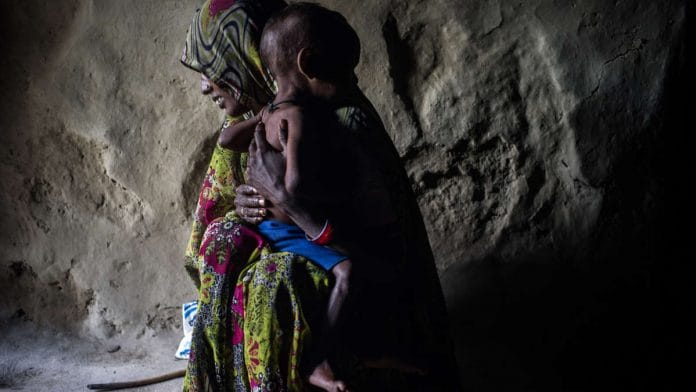New Delhi: India suffers from a “serious” level of hunger, with a ranking of 102 out of 117 countries, according to the Global Hunger Index, a report released by the International Food Policy Research Institute (IFPRI).
The report uses four indicators — undernourishment, child wasting, child mortality and child stunting —to calculate hunger. India’s current GHI score, 30.3, reflects an improvement in some of these indicators compared to the years preceding it. On GHI, India scored 38.8 in 2000, 38.9 in 2005, and 32 in 2010.
But India’s global rankings, when seen together, appear to have slipped from 2017 (when it ranked 100 of 119 countries) and marginally improved from 2018 (where it ranked 103 of 119 countries), where 0 indicates the best ranking, and above 100 the worst.
The IFPRI report, however, says this year’s rankings cannot be directly compared to the rankings of previous years because of changing parameters and the addition/subtraction of countries counted in the report.
India’s current 2019 ranking puts it behind Pakistan (94), Niger (101), and North Korea (92).
Poor performance in child wasting
Even as India’s performance has improved in undernutrition, child stunting and child mortality, it’s performance when it comes to child wasting, which indicates low weight for height, has deteriorated.
In 2000, 17.1% of children under the age of 5 showed signs of wasting, but that number has risen in 2019 to 20.8%.
“India’s rate of child wasting is extremely high at 20.8 per cent — the highest wasting rate of any country in this report for which data or estimates were available,” says the report, adding that it could have implications for South Asia’s ranking as a region.
“Because of its large population, India’s GHI indicator values have an outsized impact on the indicator values for the region,” it says.
Keeping India company in its poor rankings of child wasting are war-torn Yemen and Djibouti.
Also read: Students’ performance in govt schools suffer if they are hungry: Study
Other indicators still poor
India has made improvements in child nutrition (18.2% in 2000 to 14.5% in 2019), child stunting (54.2% in 2000 to 37.9% in 2019) and under-five mortality rate (9.2% in 2000 to 3.9% in 2019).
The report says that child stunting, though reduced, is still “very high in terms of its public health significance”.
“In India, just 9.6 per cent of all children between 6 and 23 months of age are fed a minimum acceptable diet,” notes the report.
Water sources and sanitation can also have an impact on India’s hunger index, the report suggests, noting that as of 2015-16, “90 per cent of Indian households used an improved drinking water source while 39 per cent of households had no sanitation facilities (IIPS and ICF 2017)”.
“In 2014 the prime minister instituted the ‘Clean India’ campaign to end open defecation and ensure that all households had latrines. Even with new latrine construction, however, open defecation is still practiced. This situation jeopardises the population’s health and consequently children’s growth and development as their ability to absorb nutrients is compromised.”
Climate change and the global picture
The GHI score for 2019 for the world is 20.9, which can be classified as borderline “moderate” and “serious”.
“This value reflects a decline in the global GHI score in each period examined since 2000, when the global GHI score was 29.0 and fell into the serious category. This achievement coincides with a global decline in poverty and increased funding for nutrition initiatives worldwide,” says the report.
“However, current action and spending are still insufficient to reach global goals such as the second Sustainable Development Goal — Zero Hunger — and the World Health Assembly global nutrition targets to which countries have declared their commitment. Furthermore, we need to strengthen our efforts to cope with extreme climatic events, violent conflicts, wars, and economic slowdowns and crises that continue to drive hunger in many parts of the world.”
Also read: Number of stunted children in India fell 30% in a decade, but it’s slow progress







Ha ha sure it is bad but also look at number of participants over the years.commis are good at skewing the information.
मोदी है इसीलिये मुमकीन है